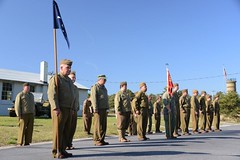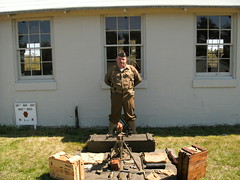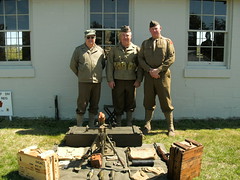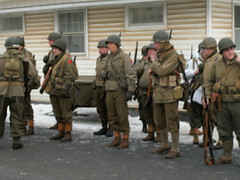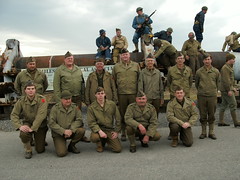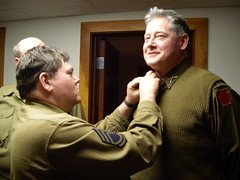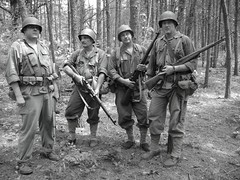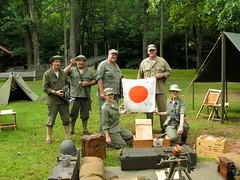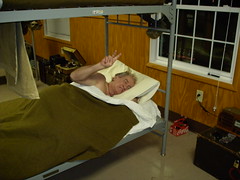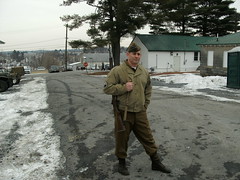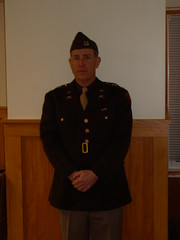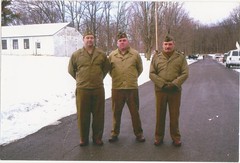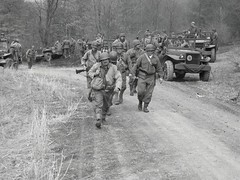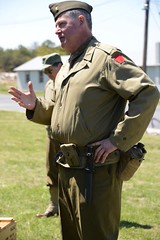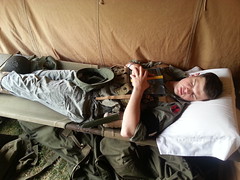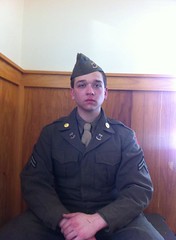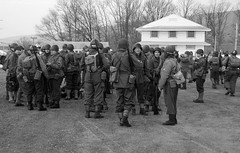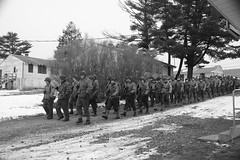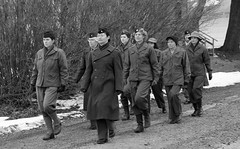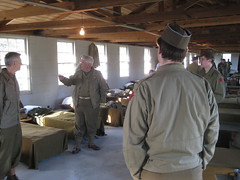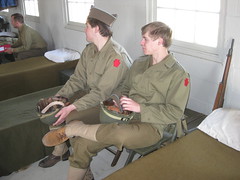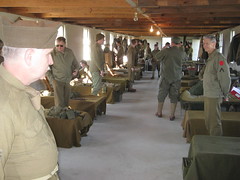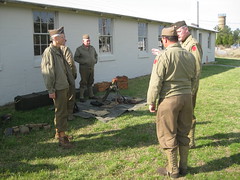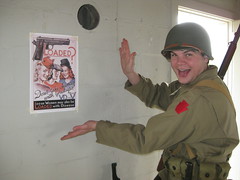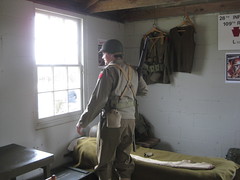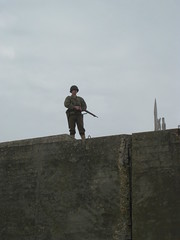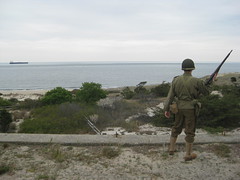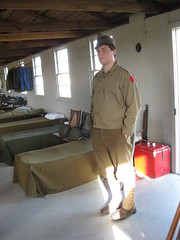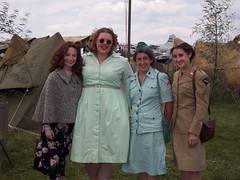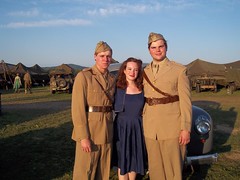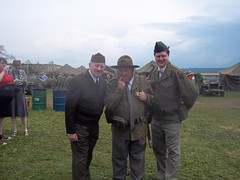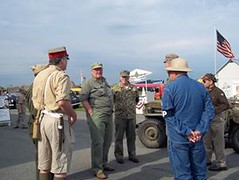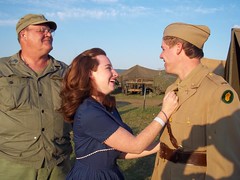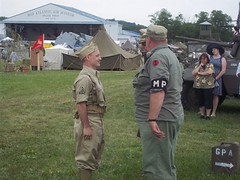A Brief Introduction
This is a 20th century, World War II re-enactment unit. It is one of several units that comprise the parent organization, Historical Military Impressions (HMI). Each member pays annual dues and maintains his or her own uniform and equipment. Tents are provided by HMI for the troops that wish to stay in the field at events. Join the proud men and women who re-enact the history of our involvement in World War II.
The company portrays a Pennsylvania Army National Guard unit deployed to the European theater in 1944, and during the Mid-Atlantic Air Museum’s (MAAM) WWII Weekend at Reading, PA, they act as MPs for MAAM and also portray the 7th Infantry Division, which was located on the west coast of the US and deployed to fight in the Pacific theater in 1943.
Along with the soldiers, the women of HMI portray members of the Women's Army Corps (WACS). The unit also demonstrates life back home during the war through the “Home Front” display, where you may see everything from clothing to ration stamps. The spirit of the fighting men and women of our country has not been forgotten, and is preserved by the members of HMI through living history demonstrations and battle re-enactments. Throughout the year, we go to historical sites and large venues, and return to the 20th century. Annual battle re-enactments include the Battle of the Bulge at Ft. Indiantown Gap, PA, Graeme Park in Horsham, PA, and the Mid-Atlantics Air Museum’s WWII Weekend in Reading, PA.
Members of the unit are very helpful to new recruits by guiding them during the time that they are putting together their impression. The unit is currently commanded by Tom Mellon. He may be contacted at fx2go4@yahoo.com.
If you are interested in knowing more about the unit or are ready to get involved, fill out the brief membership application and contact Bill Fisher at fish64@enter.net
History of the Company
The 28th Division arrived in France in July 1944 and fought its way to Germany. A small night patrol of the 109th Infantry Regiment began the division's protracted struggle on the Siegfried Line on the Dragon's teeth (fortification) infested Westwall.
The patrol crossed the Our River by bridge from Weiswampach, Luxembourg into Sevenig (Our), Germany, making it the first of the Allied armies to reach German soil. The Division, whose divisional patch is the red keystone, paid a heavy price in the Battle of Hurtgen Forest or "Green Hell" during November of 1944. The 28th suffered excessive casualties that autumn.
The campaign was the longest continuous battle of World War II. The Division earned the nickname "The Bloody Bucket" by the Germans, who had faced the fury of the Division's attacks during this campaign. In the Ardennes campaign, commonly known as the Battle of the Bulge, the Division bore the brunt of the German counter offensive. The Ardennes Offensive was launched along the entire divisional front by the Fifth Panzer Army led by General der Panzertruppe Hasso von Manteuffel.
The 28th, which had sustained heavy casualties in the First Army drive to the Roer, fought doggedly in place using all available personnel and threw off the enemy timetable before withdrawing to Neufchâteau on 22 December for reorganization, as its units had been badly mauled. The Division fought in five campaigns and suffered over 16,000 killed or wounded in action. The 109th Infantry Regiment (United States) received the French Croix de guerre from French Prime Minister Charles de Gaulle. The division returned to U.S. on 2 August 1945 and was inactivated on 13 December 1945.

Required Clothing
Shirt, wool, M1937 OD, light shade (mustard), enlisted pattern with the Keystone patch. When looking for Keystone patches, look for the white thread on the back, the more white thread the better.Trousers, wool serge, M1937 OD, Light shade (mustard), enlisted pattern. Be aware that the M1945 trousers are close in color but have a pocket flap for the rear pocket. These trousers should not be worn.
Belt, trousers, light OD or khaki with open square frame buckle.
Boots, rough out. (Black boots or lug soled boots are NOT acceptable) The low quarter service boots are preferred as they can be worn for both early and late war events. Also acceptable are the M1943 Combat boots with the double buckles at the top. We recommend purchasing authentic reproductions.
Leggings, M1938 dismounted, light OD. These are required if the low quarter rough out boots are worn.
Jacket, Field M1941 or M1943. Original M1941 jackets are expensive and hard to find in good condition, we recommend purchasing an authentic reproduction.
Cap, Garrison (a.k.a. Overseas cap), plain or with light blue piping.
Neck tie, khaki. This is required for parades and use in a garrison setting such as events at Fort Indiantown Gap.
Eyeglasses : Round gold or silver metal frames are required. Incorrect eyeware is the fastest way to destroy an authentic impression
Items to Get Later
Knit cap, M1941 (Jeep cap). Original M1941 caps are expensive and very hard to find in good condition, we recommend purchasing an authentic reproduction. Stay away from the current issue green caps, the WWII versions were more brown in color. This cap will only be worn underneath of the helmet and not as replacement for the Garrison cap (overseas cap).Under shirts & Under shorts, light OD, correct reproductions now exist so either they or original could be worn. The shirt is to be the "tank top" version. The current brown issue shirts shall not be worn unless they are totally covered up.
Socks, light OD wool/cotton cushion sole.
M1938 4 Pocket blouse (must have correct collar disc & keystone patch). The M1944 (a.k.a. Ike jacket) was not issued to the enlisted men until very late in the war.
"Class A" uniforms shall be void of all valor medals, achievement awards, and discharge patches (CIB, bronze stars, good conduct, etc). The ETO ribbon may be worn as the Regiment was authorized to wear it in 1943. As we portray the Regiment during the winter of 44 – 45, there shall be no more than two (2) campaign stars worn on the ETO ribbon. As for overseas service stripes (Hershey Bars), no more than two shall be worn as each is for 6 months of overseas service and the Regiment did not arrive in Wales until October 1943.
If you have earned valor and/or achievement awards with service to our current military, then the WWII version may be worn.
Low Quarter Russet Service boot, Russet color to be worn with the Class A uniform. A correct period Oxford type shoe may also be worn.
M1929 / M1942 Wool overcoat. The M1939 will have brass buttons and the M1942 coat will have plastic buttons.
Sweater, OD, 5 button, "V" neck, crew neck or vest. Correct reproductions now exist for these or you can wear an original. The modern issue sweater is not correct for our impression.
Scarf, OD knit wool. In lieu of an actual scarf you could cut up an old worn out army blanket into long strips.
Gloves. May either be the leather palmed wool gloves, which are being reproduced, or an OD wool knit type.
Equipment
Helmet, M1 and liner, w/light OD web straps. Helmet must be dark OD in color and have the seam in the front with either fixed or swivel bales. The webbing inside the liner will not be stitched together as this is post-war, the internal loops will be tied together with a cord. Division insignia may be painted on the helmet. However not many would have been seen as the war progressed as there were many replacements that entered the Division. The chinstraps of the helmet must be SEWN and not clamped onto the metal loops of the shell.M1 Garand, with reproduction M1907 leather sling or web sling with the FLAT keeper. The keepers with the bump were post-war. The M1 Carbine will be used by the officer only, unless prior arrangements have been made.
Bayonet, (M1942, both the 10" and the cut down are acceptable).
Cartridge Belt, M1910 or M1923, light OD or khaki.
Canteen, M1910 or M1942 with light OD cover and cup.
Pouch, First Aid, M1910 or M1942, light OD with Carlisle packet.
Haversack, M1910 or M1928 with meat can carrier, light OD.
Meat Can, M1910 or M1926 with M1926 utensils.
Entrenching tool, M1910 (T-handle shovel) with M1910 carrier, or a war dated M1943.
Shelter half, Light OD single ended bell, with pole, pins & rope. The single ended tent is preferred, however a War dated double bell half is also acceptable. Snaps did not appear on the tents until after the Korean War.
M6 Army Lightweight service gas mask bag. This good to carry rations and other small items with when in the field.
Blanket, wool light OD. Do not get the dark green blankets. For garrison events you will need two of them to make the bunk properly.
2 Bandoleers, light OD. Must have the neat stitching not the zig-zag stitch of the post war version
The M1936 suspenders and mussette bag shall be worn by the officer only, unless prior arrangements have been made. The cartridge belt may be either worn by itself or with the Haversack, both methods are proven through period photographs and accounts.
The bayonet and entrenching tool will be worn, either on the cartridge belt or on the haversack. They carried them so we shall carry them.
As we portray a National Guard unit, World War One issue web equipment is also acceptable.
When purchasing equipment it is better to look for gear from the early part of the war, pre-1943. These items will be more khaki in color, which is correct for our impression. The dark OD green colored items were issued later in the war and should be avoided for our impression.
M1944 and M1945 field gear will not be worn.
Other Approved Items
Dog Tags, notched.Watch, GI or civilian, correct style of the period.
Ditty Bag, OD. Correct style of the period for carrying personal items.
Helmet net, with small holes.
Winter Combat (Tanker) Jacket.
M1938 Raincoat.
M1943 wool sleeping bag.
Mackinaw, any one of the three patterns
Duffel bag, single strap. The double strap version is a modern issue.
Foot Locker, for garrison events to store items and a place to sit.
Herringbone Twill, Jacket, Trousers, and Hat. These are good to have for the summer events.
Reference Books
Government Issue Collector's Guide "U.S. Army European Theater of Operations"
by Henri-Paul Enjames
Doughboy to GI, US Army Clothing and Equipment 1900-1945
by Kenneth Lewis
The World War II GI, US Army Uniforms 1941-1945 in Color Photos
by Richard Windrow & Tim Hawkins
US Infantry Weapons of World War II
by Bruce N. Canfield
US Army Handbook 1939-1945
by George Stanton
US Army Uniforms of World War II
by Shelby Stanton
Uniforms, Weapons of World War II GI
by Stephen Sylvia & Michael O'Donnell
Personal Accounts
G Company's War
by Bruce Egger & Lee MacMillian Otts
There's a War to be won, The United States Army in World War II
by Geoffrey Perret
GI, the American Soldier in World War II
by Lee Kennett
Roll Me Over, an Infantryman's World War II
by Raymond Gantter
If You Survive
by George Wilson
Enemy North, South, East, West
by Robert Weiss
The World Within War
by Gerald F, Linderman
Before Their Time
by Robert Kotlowitz
Company Commander, The classic Infantry Memoir of World War II
by Charles B. MacDonald
Closing with the Enemy, How GI's fought the War in Europe, 1941-1945
by Michael Doubler
The GI's War, American Soldier in Europe during World War II
by Edwin P. Hoyt
Overpaid, Oversexed, & Over Here, The American GI in World War II Britain
by Juliet Gardiner
The Regiment, Let The Citizens Bear Arms
by Harry M. Kemp
To Save Bastonge
by Robert F. Phillips
The Deadly Brotherhood "The American Combat Soldier in World War II"
by John C. McManus
Infantry Soldier "Holding the line at the Battle Of the Bulge"
by George W. Neil
Web Sites
WWII Impressions - Top quality reproduction American uniforms and footwear
At The Front - Original and repro GI items
The Battle of the Bulge site
World War 2 Ration Technologies
What Price Glory - Original and Repro items
National Museum of Military History - Diekirch, Luxembourg
